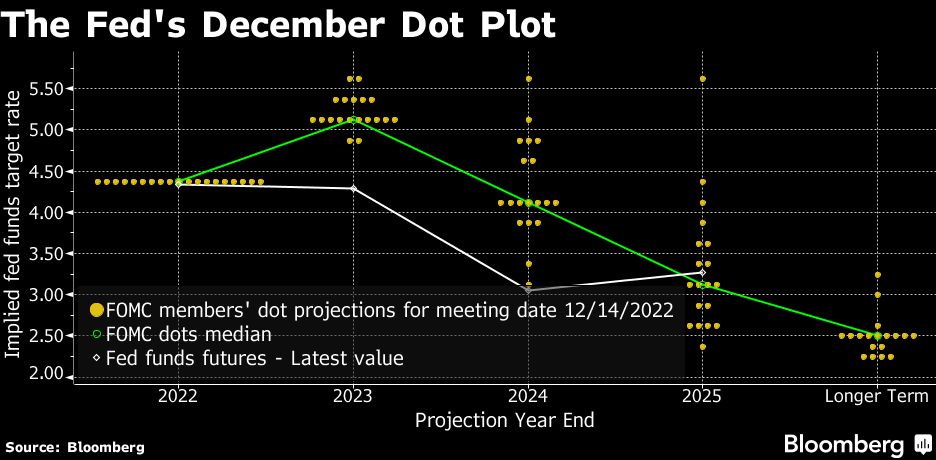The Federal Reserve’s policy makers are going to become incrementally more dovish in 2023, as a new roster of senior officials brings a greater focus on maximum employment to its policy-setting committee.
(Bloomberg) — The Federal Reserve’s policy makers are going to become incrementally more dovish in 2023, as a new roster of senior officials brings a greater focus on maximum employment to its policy-setting committee.
With the Federal Open Market Committee’s annual rotation of voters on monetary policy, James Bullard of the St. Louis Fed, Loretta Mester of the Cleveland Fed and Esther George of the Kansas City Fed — all of whom have favored sharply higher interest rates to help curb inflation — will lose their votes. Boston’s Susan Collins, a newcomer who’s considered to be neutral, will also lose her voting seat.
Coming on as FOMC voters will be the Chicago Fed’s new president, Austan Goolsbee, believed to be dovish, Philadelphia’s Patrick Harker and Dallas’s Lorie Logan, both seen as centrists, and Minneapolis’s Neel Kashkari, who is currently an arch hawk.
The upshot is that policy doves, who are especially attuned to the health of the labor market, are likely to have a greater weight around the table during the eight policy meetings in 2023.
The actual impact might be initially hard to discern. There’s little distance in the views of doves and hawks at the moment — 17 of the 19 officials saw the Fed’s target rate exceeding 5% by the end of next year, and none expected to cut rates in 2023, according to their latest economic projections. Also, Chair Jerome Powell has led one of the fastest rate-hiking campaigns in decades with little dissent, a reflection of his strong control over the committee.
“The set of new 2023 voting members appears to have general policy preferences that are more on the dovish side than the outgoing set,” said Roberto Perli, head of global policy research at Piper Sandler & Co. “However, the committee is very unified. This tells me that the bar for stopping at a lower peak or for cutting rates in 2023 is high, regardless of who votes and who doesn’t.”
What Bloomberg Economics Says…
“Altogether, the doves are set to gain two seats on the voting committee in 2023, gaining further traction in the decision-making process. We believe half of the 12 voting members in 2023 will likely belong to the dovish half of the distribution, in comparison to only four this year.”
— Anna Wong (chief US economist)
To read the full note, click here
Fed officials lifted interest rates by a half percentage point last week, bringing their benchmark to a target range of 4.25% to 4.5%. They also released forecasts showing rates ending next year at 5.1%, according to their median estimate, with no rate cuts before 2024.
Among 2023 voters, Goolsbee, who will start on Jan. 9, hasn’t given his opinion on monetary policy since his Dec. 1 appointment. In an Oct. 31 Bloomberg Radio interview, Goolsbee said a peak for the benchmark federal funds rate around 5% “kind of makes sense to me.” The chair of former President Barack Obama’s Council of Economic Advisers has blamed inflation significantly on supply shocks, suggesting tighter monetary policy alone won’t be enough to curb price pressures.
Logan, a former New York Fed official, hasn’t spoken much on monetary policy since her selection to lead the Dallas Fed but said in November “there is still a long way to go” to fight inflation. Harker said last month he expects officials to slow the pace of their interest-rate increases and eventually hold rates at a restrictive level for a while.
Kashkari is the most hawkish of the four and last month said he wasn’t persuaded inflation had peaked, adding that “I’m not seeing much evidence of cooling” in the economy. At one point the Minneapolis chief was a dove, and he illustrates that Fed officials can sometimes be difficult to categorize.
“There has been flipping of stances among some officials,” said Kathy Bostjancic, chief economist at Nationwide Life Insurance Co. Overall, “Chairman Powell does have good control of the committee and there are not large differences between the hawks and doves,” she added.
There were just two dissents in 2022: George dissented in June in favor of a smaller rate increase, and Bullard dissented in March, calling for a bigger initial hike. Powell has had just 12 dissenting votes over his five-year tenure as chair, averaging fewer than one negative vote every three meetings. Most of the dissents were in 2019, early in his first term.
Conditions in 2023 could lead to more dissents. Most economists are expecting higher rates to cause a recession, with the unemployment rate rising to 4.9% in early 2024 from 3.7% last month, according to the latest Bloomberg monthly survey of economists.
“We might see some dissents on the dovish side next year if or when the unemployment rate starts climbing above the natural rate” – estimated around 4% by the FOMC — “if inflation remains elevated,” Perli said. “I doubt that the dissents would come quickly and that they would be more than one or two. The chair will still be able to manage the committee very effectively.”
–With assistance from Kathleen Seaman.
(Updates with policymakers’ forecasts in fifth paragraph.)
More stories like this are available on bloomberg.com
©2022 Bloomberg L.P.










